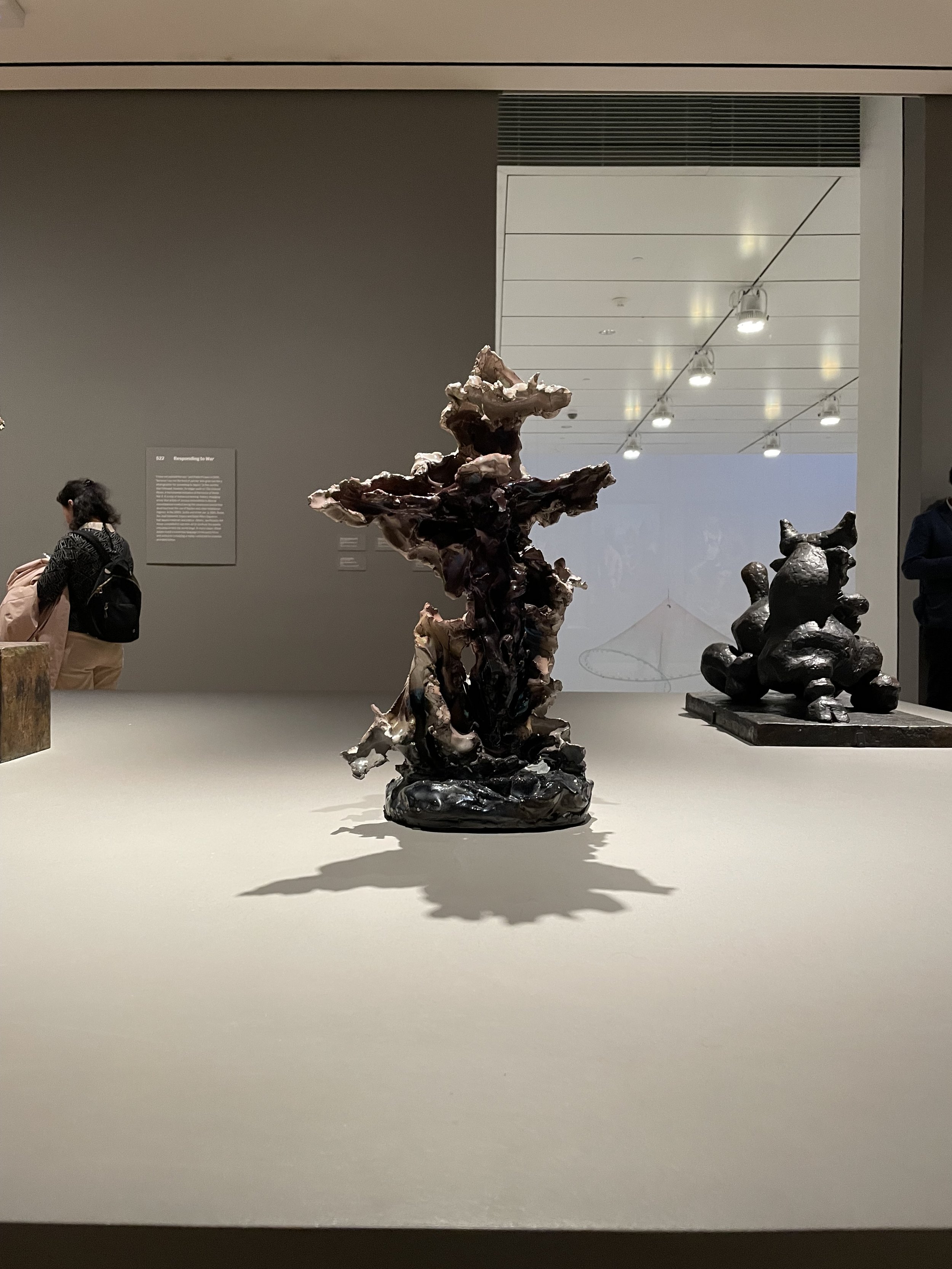Researching Ceramics: Lucio Fontana’s “Crucifixion”
On approach, the piece seemed overshadowed by a nearby bronze statue of what looked like a cow seated on a large base. The dancing three dimensional brush strokes (of what I realized later was the back of the piece) rise up and splash away from the bronze cow as if waves of glaze were crashing against a cragged sea-side cliff. The shape of this piece felt like the salty ocean waves, topped with seafoam as they crash into earth. Not until I walked to the other side of the room did I see that the waves of Lucio Fontana’s “Crucifixion” are constructed around the form of a cross. With incredible movement, the piece feels organic and yet highly constructed. “Crucifixion” has two dramatically opposing sides: one that is light, shimmering in the dim gallery spotlights, and the other which sits under the shadows of the creamy ceramic waves. The crystal-like glaze of the light side pools and drips over the cascading clay body: and the darker side evokes the feeling of seeing the entrance to a cave: the darkness of the unknown leaves one groping for clarity or shape in the shadows. Below these two sides sits a deep blue pedestal, like the primeval sea that seems to contains everything, yet is formless.
Back of “Crucifixion,” showing the lighter “waves of ceramic.”
While the Fontana’s piece clearly points to the Christian religious themes of Christ’s death on a cross; the piece also feels related to another important story in the Christian religious tradition: the creation story told in the book of Genesis. The dark blue base of the sculpture, which unites both sides of the piece, feels like the “formless void,” or the “darkness over the face of the deep” (English Standard Version Bible, 2001, Genesis 1:2). The two sides of the sculptural form rising from the depths feel like the moment frozen in time as “God separated the light from the darkness…” and says, “Let there be an expanse in the midst of the waters, and let it separate the waters from the waters” (English Standard Version Bible, 2001, Genesis 1:3-7). Using a Jungian psychological lens, the creation story in Genesis points to the creation of human consciousness (Stewart, 2014). In this tradition, light can be seen as consciousness: providing clarity and understanding, while darkness holds formless, yet almost infinite potential. When viewing the “Crucifixion,” I was drawn to the lighter side of the piece, seeing the darker crucifix form and quickly turning back to revisit the glossy peaks of the other side. When seen with a psychological lens, this urge to view the lighter side reveals my own (and perhaps other humans’) desire to avoid the more shadowy sides of the human psyche. It is curious that Fontana seems to relegate the most celebrated icon of the Christian faith into the shadows. Is this piece speaking to the struggle of light and dark in the psyche, or perhaps it points to the cyclical nature of consciousness throughout history?
Regardless of the psychological implications of this piece, it stands powerfully both conceptually and technically. The way that Fontana creates such movement with clay feels exhilarating, his use of glazes in response to form also plays with the mind. At first glance, the piece feels very abstract and instinctual; as if Fontana threw a bunch of clay against a crucifix form and dipped it in glaze. However, the depth of the piece seems to indicate that none of this was created by chance; at closer observation, the waves and forms of clay seemed to grow organically from the crucifix form, revealing the artist’s touch and intention. Lastly, the three-dimensional nature of the piece leaves the viewer wondering: which side is the front? (Or more psychologically, which side is “right?”) My instinct was to sit beneath the form and look up to it as I observed its many sides, perhaps speaking to the way a congregant might celebrate mass under a looming crucified Christ. For my personal work, this piece raises questions about the impact of sculptural work on the viewer and the way that objects can carry significant symbolic meaning while also expressing extremely primal or instinctual feeling.
Artist: Lucio Fontana (Italian, born Argentina. 1899-1968)
Title: Crucifixion
Year: 1948
Medium: Glazed ceramic
Dimensions: (approx.) 10 in. x 6 in. x 24 in.
Place of Viewing: Museum of Modern Art (Floor 5, 522The Alfred H. Barr, Jr. Galleries)
References
English Standard Version Bible. (2001). ESV Online. https://esv.literalword.com/
Fontana, L. (1948). Crucifixion. [Glazed ceramic]. Museum of Modern Art (Floor 5, 522The Alfred H. Barr, Jr. Galleries). New York City, NY.
Stewart, D.J. (2014), The Emergence of Consciousness in Genesis 1–3: Jung's Depth Psychology and Theological Anthropology. Zygon, 49: 509-529. https://doi.org/10.1111/zygo.12086



